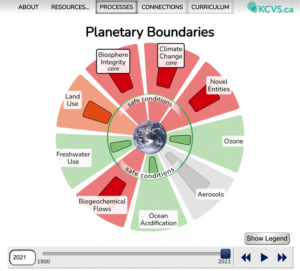Global Release of Interactive Planetary Boundaries Systems Thinking Learning Tool to Connect Chemistry to Sustainability
 To coincide with the launch of the International Year of Basic Sciences for Sustainable Development, on 8 July 2022, the King’s Centre for Visualization in Science and a working group of the IUPAC Systems Thinking in Chemistry for Sustainability (STCS-2030+) project announce the release of a new free interactive tool for global dissemination based on the Planetary Boundaries framework to help chemists and educators better understand Earth system sustainability challenges and to connect chemistry to sustainability using systems thinking.
To coincide with the launch of the International Year of Basic Sciences for Sustainable Development, on 8 July 2022, the King’s Centre for Visualization in Science and a working group of the IUPAC Systems Thinking in Chemistry for Sustainability (STCS-2030+) project announce the release of a new free interactive tool for global dissemination based on the Planetary Boundaries framework to help chemists and educators better understand Earth system sustainability challenges and to connect chemistry to sustainability using systems thinking.
The new tool, freely available at https://planetaryboundaries.kcvs.ca/, highlights the fundamental role that chemistry plays in regulating nine individual biophysical Earth system processes and in determining their control variables. It introduces and builds on the Planetary Boundaries framework, first published in Nature in 2009 by twenty-eight scientists led by Johann Rockstrӧm and colleagues at the Stockholm Resilience Centre. The Planetary Boundaries framework is a structure for understanding the many ways humans are influencing the Earth system, how those influences interact, and how they threaten sustainability. Chemistry plays a key role in monitoring and understanding the impacts and interactions of Earth systems processes on planetary health and human society and is fundamental to working towards solutions to the sustainability challenges identified by the framework.
The new interactive tool features three entry points. The “processes” view visualizes the status of control variables for nine Earth system processes in the Planetary Boundaries framework, emphasizing their change over time and how together they provide a dashboard of sustainability which helps tell the story of the state of our planet because of human activity. Clicking on the “connections” view opens an interactive network diagram that visualizes the web of Earth system process connections and briefly describes key Earth system connections to a selected process. Finally, the “curriculum” interactive tool provides educators with accessible entry points to support the integration of chemistry curriculum content with sustainability considerations. A secondary or post-secondary educator can select a topic they teach, such as “equilibrium,” “thermochemistry,” or “gases” and explore how they can connect that topic to sustainability considerations. This interactive curriculum map and accompanying lessons for teachers will be developed further during the International Year of Basic Sciences for Sustainable Development by KCVS researchers and the IUPAC STCS-2030+ working group.
A detailed description of the interactive learning tool is available at ChemRxiv (11 July 2022) <https://doi.org/10.26434/chemrxiv-2022-84bz2>
The King’s Centre for Visualization in Science (KCVS.ca) is a research and dissemination centre of the King’s University in Edmonton, Alberta, Canada, directed by Peter Mahaffy. KCVS disseminates free, peer reviewed learning resources to see and understand science, accessed by a half-million users around the world each year. KCVS has collaborated with IUPAC to create interactive learning resources on numerous other projects, including tools to explain climate change, visualize the interactive IUPAC Periodic Table of Isotopes and Elements, and to explore the multiple uses of chemicals in collaboration with both IUPAC and OPCW.
